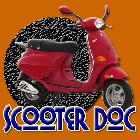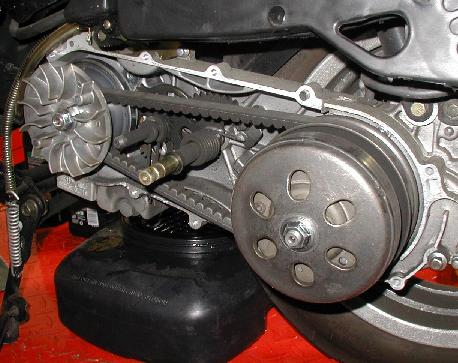Motor Scooters: stepless transmission, Continuously Variable Transmission (CVT)
Site Map
What's New
Features
Scooters from Amazon.comYes Man, Scooters in Film
Larry Crowne and scootering
Helmet Free scootering
Scooters in a failing economy
Scooter Economy
Scooter ROI Analysis
Scooter pays for itself
Types of Motorscooters
Why ride a scooter?
Motorscooter FAQ
Buying Scooters Online
Join Our Mailing List
Recommend this site
Scooter Inspiration
Scooter EconomyMotorscooter Advantages
Motorscooter Disadvantages
Motorscooter Books
Motor Scooter Poetry
Business Scooter Travel
Motorscooter Posters
Motorscooters in California
Scooting in the UK
Green Scooting in China
Scooting in Italy
Motorscooters in Iraq
Motor Scooter History
The Ice-Cream Scooter
Pets and Motorscooters
RVs and Motorscooters
Gas vs. Electric Scooters?
Put-putting Pleasures
Recommended Scooters
Scooter Culture
Larry Crowne (film)
Dating and Scooter Culture
Motorscooter Freedom
Motor Scooter Image
Scooter Lib
Back to School on a scooter
Motor Scooter Music
Motorscooter Camping
Types of Motorscooters
Classic Motor ScootersItalian Motor Scooters
The Vespa Motorscooter
The Aprilia Motorscooter
Falcon Electric Scooters
50cc Motorscooters
Kymco Motorscooters
GT Chaunl Scooters
Chinese Motor Scooters
TANK Motorscooters
The RoadRunner Scooter
Roketa Motorscooters
The I-scooter
Moped Scooters
Mopeds
Scooter Choices
Best Scooter DealsThe Performance Scooter
The Luxury Scooter
The Minimalist Scooter
The Classic Scooter
The Basic Scooter
The I-scooter
The Electric Scooter
Stand-up Scooters
The Mobility Scooter
Used Motorscooters
California Legal Scooters
Toy Scooters
Practical matters
Trouble starting a scooterScooters and the Environment
Scooter Return On Investment Analysis
Motor Scooter Repair
The Scooter Commute
Scooter Repair Shops
Scooter Replacement Parts
Vespa Repair
Scheduled Maintenance
Fuel Efficient Driving
Essential Scooterist Kit
Passengers on a Scooter
Motor Scooter parking
Using the Kick Starter
Motor Scooter Batteries
Motor Scooter Stands
Rotating a Scooter
Cargo Storage Issues
Chinese Scooter Alarms
Scooter Roadside Assistance
Affordable Insurance
Scootering in groups
Motorscooter safety
Motorscooter SafetyDriving a Motorscooter
MSF Manual: Your Scooter
Scooters and Potholes
Important, before you drive
Motorscooter Helmets
All-weather Scootering
The Oily Path of Safety
Motorscooter Journal
Motorscooter JournalOff-highway scooter routes
The Scooterdoc
Scooter Choice Ethics
India Shuns Scooters
Left-handed Motorscooters
Other Types of Scooters
Mobility ScootersScooter-inspired Vehicles
Electric Motorscooters
The Three-wheel Scooter

Vespa Service In
Southern California
The Stepless Automatic Transmission

What is a Stepless Transmission?
With a stepless transmission there is no clutch, there is no gear shift, and on a scooter, there is not even a shift control of any sort. One does not not even sense a shift of gears while driving. This makes scooter riding extremely simple and easy but there are a couple of dangers that are worth noting. First some basic concepts.
The internal combustion engine is most powerful when running within fairly narrow RPM (Rotations Per Minute) range (unlike other engines such as steam or electric which are not nearly as limited). In order to accelerate a vehicle over a wide range of velocities while the engine remains within its optimum RPM range, gears are used to change the ratio of motor RPM to wheel RPM. In manual and standard automatic transmissions these ratio shifts take place several times during acceleration and are handled manually by the driver or automatically by the transmission respectively.
More correctly known as a Continuously Variable Transmission (CVT), the stepless transmission used in most modern motorscooters is a type of automatic transmission whose "gear ratio" changes automatically to any arbitrary setting within the limits of the system and is not constrained to a discrete series of specific ratios -- the 3 or 4 ratios of typical automotive transmissions. As a result, accelerating with a CVT is a very smooth uninterrupted process. On the motorscooter, this effect is achieved using a belt between two pulleys whose effective radii are variable and change according to the speed of the vehicle -- one radius increasing while the other decreases -- thus accommodating a constant belt length.
The Starting Disadvantage
While a stepless transmission makes a scooter wonderfully easy to ride, there is one significant disadvantage. Modern motorscooters often have starting problems. The batteries are pittifully inadequate and the kickstarters, through capable of starting the engine under ideal coditions, are rather limited. While a motorcycle with a manual transmission can easily be push-started no matter how dead the battery is or how wet the sparkplug is, an automatic motorscooter cannot.
Things to watch for
Normally the driver of a CVT scooter need pay little heed to the transmission operation but there are some points to keep in mind.
It is easy to go faster than you realize. When accelerating, the engine at first revs up to its comfortable RPM range and then remains there while acceleration continues as the ratio changes to make wheel RPM faster while engine RPM remains the same. The driver of traditional transmissions is used to gauging vehicle speed by motor speed as, within one gear, they are always fixed relative to each other. Such a driver is not expecting vehicle speed to continue increasing while engine RPMs remain constant and may easily not notice as speed increases.
In order to accelerate to, and then maintain an optimum target speed on a CVT motorscooter, one has to get used to engine speeds first increasing, then remaining constant, and, as one approaches the desired speed, easing off on the throttle and experiencing and recognizing the seemingly unnatural sensation of motor speed decreasing while vehicle speed continues to increase -- yes, that is exactly what is happening as the CVT continues to shift gradually up. Scooterists find themselves automatically making accommodation for this phenomenon, in many cases without even noting this peculiar anomaly which is thoroughly unknown with traditional gearing systems. Still it is worth knowing what is happening and understanding the process.
Stepless transmission: belt slip
Belts do stretch over time and as they loosen fail to transmit power to the wheels. Belt replacement is one of the standard maintenance chores of the CVT scooterist. Symptoms indicating belt replacement are very simply: engine is running fine but scooter is not going anywhere. Keep a spare belt handy.
Apparent but deceptive belt slip
When one starts climbing a steep hill with some speed, one experiences another sensation unknown to drivers of traditional transmissions -- the scooter slows down dramatically while motor speed increases. This can certainly give the impression that the belt is slipping, that the work of the engine is becoming ineffectual. Actually, this is simply the effect of the CVT "gearing down." Of course, when the belt does begin to slip, it stands to reason than it will first be noticeable going up a steep hill, so pay attention to what is happening.
Belt Replacement
Belt replacement is a bit tricky. This is made far more complicated by the fact that belt sizes on Chinese scooters can vary a good deal even within the same make and model. The belt size is indicated on the outside of the belt and should always be provided when ordering a replacement (just saying that it is a TANK Racing 150 is not enough). It is well worth the cost of a spare belt to have one handy. Incidentally, the belt supplied with the Roketa is Kevlar and of a higher quality than that which comes with the TANK. .
Bookmark this page to: